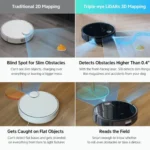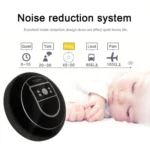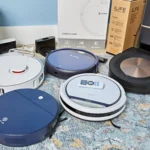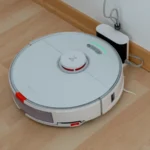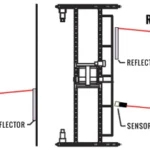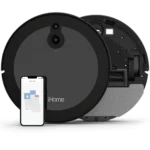Imagine having an efficient vacuum cleaner that autonomously navigates around your house without hitting any obstacles. It seems almost miraculous, doesn’t it? But the truth is, this technological marvel is made possible by a key component – the anti-collision sensor. In this article, we will explore how these sensors work, and how they perform in different types of flooring. We will also examine the factors that affect their performance, and provide some tips on how to optimize their effectiveness. So let’s dive in and discover the fascinating world of anti-collision sensors!
What are Anti-Collision Sensors?
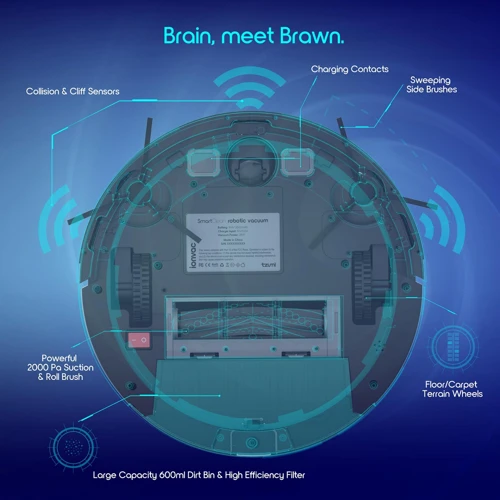
As smart home technology continues to advance, cleaning routines are made easier with the help of anti-collision sensors. These sensors are now commonly present in many modern vacuum cleaners, including the ones designed for smart home systems. Anti-collision sensors provide these devices with an incredible ability to navigate through spaces without bumping into obstacles, causing damage or getting stuck. But what are anti-collision sensors, and how do they work? Let’s find out. For a deeper dive into smart vacuum technology, check out our article on tech and anti-collision sensors.
How Do They Work?
Anti-Collision Sensors are becoming increasingly popular in robot vacuum cleaners, as they help to prevent accidents and damage to furniture and other objects in the room. These sensors work by detecting objects that are in their path, allowing the robot to navigate around them without causing any damage.
The different types of Anti-Collision Sensors include:
| Type of Sensor | Description |
|---|---|
| Infrared Sensors | These sensors beam infrared light in front of the robot and detect objects by measuring the reflection of the light. This allows them to detect objects even in low light conditions. |
| Ultrasonic Sensors | These sensors use high-frequency sound waves to detect objects in front of the robot. They are especially good at detecting soft objects such as curtains or bedding. |
| Cliff Sensors | These sensors are used to detect drops or cliffs so that the robot does not accidentally fall down stairs or off a ledge. |
| Bumper Sensors | These sensors are located on the front and sides of the robot and are used to detect when the robot has collided with an object. They are the most basic type of Anti-Collision Sensor. |
When an Anti-Collision Sensor detects an obstacle, it will send a signal to the robot’s microprocessor. The microprocessor will then instruct the robot to stop or change direction, allowing it to avoid the obstacle.
It is important to note that Anti-Collision Sensors are not foolproof and may not always work as intended. Factors such as lighting conditions, the position of furniture and other obstacles, and the type of flooring can all affect their performance.
To learn more about troubleshooting Anti-Collision Sensors or cleaning them, check out these articles: Troubleshooting Anti-Collision Sensors and Cleaning Anti-Collision Sensors in Smart Vacuums.
Despite their limitations, Anti-Collision Sensors are an essential feature for robot vacuum cleaners, and new innovations are constantly being developed to improve their functionality. To learn more about the latest innovations in Anti-Collision Sensors and the smart vacuum market, check out this article: Innovations in Anti-Collision Sensors in the Smart Vacuum Market.
Anti-Collision Sensors and Different Types of Flooring
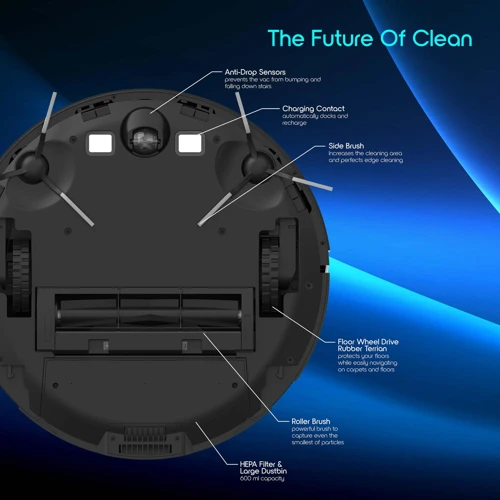
As we have learned how anti-collision sensors work in the previous section, it’s time to focus on how these intelligent sensors perform on different types of flooring. Anti-collision sensors are designed to make cleaning more efficient by preventing vacuum cleaners from bumping into objects, furniture, and walls. However, the effectiveness of these sensors may vary depending on the type of flooring they are being used on. In this section, we will explore how anti-collision sensors work on various types of flooring, including carpet, hardwood, and tiles. By the end of this section, you will be able to determine the types of flooring that work best with anti-collision sensors and how to optimize their performance.
If you want to learn more about the pros and cons of anti-collision sensors in smart vacuums, check out our previous article on anti-collision sensors in smart vacuums. Also, learn how drop sensors work in multi-level homes by reading our article on drop sensors in smart vacuums.
How They Work on Carpet
Anti-collision sensors in vacuum cleaners are designed to help prevent the vacuum from colliding with furniture and walls. These sensors usually work by using infrared or acoustic technology to detect obstacles in the vacuum cleaner’s path. However, the effectiveness of these sensors may vary depending on the type of flooring the vacuum cleaner is used on.
How do Anti-Collision Sensors Work on Carpet?
When used on carpeted floors, the performance of anti-collision sensors can be affected by several factors. The thickness of the carpet, lighting conditions, and furniture placement can all impact the vacuum cleaner’s ability to navigate around obstacles.
One of the most significant challenges is detecting obstacles hidden beneath the carpet’s fibers. This is because the pile height of a carpet can vary and affect the sensor’s range. As a result, some anti-collision sensors may not detect obstacles that are situated beneath a thick pile carpet.
To mitigate this issue, some vacuum cleaner manufacturers have implemented carpet height adjustment technology, which allows the vacuum cleaner’s sensor to adjust to the carpet’s height. This makes it easy for the device to detect obstacles that are hidden beneath the carpet.
Another factor that can affect the performance of anti-collision sensors on carpets is lighting conditions. If the lighting is too dim, the sensors may not be able to detect obstacles accurately. This is because the infrared or acoustic technology used by the sensors requires adequate light to function effectively.
Furniture placement is another factor that can impact a vacuum cleaner’s anti-collision sensors performance. If there are many obstacles in the vacuum’s path, the device may have trouble detecting them, causing the vacuum to bump into objects or push them around.
To improve the performance of anti-collision sensors on carpet, it is essential to keep the room well lit and clear of clutter or furniture. This ensures the sensors have the necessary lighting and space to detect obstacles accurately.
Below is a table that outlines the factors that can impact anti-collision sensor’s performance on carpeted floors and how to optimize their effectiveness.
| Factors that affect sensor performance on carpet | How to optimize sensor performance |
|---|---|
| Thickness and pile height of the carpet | Choose a vacuum cleaner with carpet height adjustment technology |
| Lighting conditions in the room | Ensure the room is well lit |
| Furniture and clutter | Clear the room of obstacles and furniture |
Anti-collision sensors are an essential feature of modern vacuum cleaners, especially for households with families and pets. However, their performance can be affected by various factors, including the type of flooring, lighting conditions, and furniture and obstacle placement. It is crucial to optimize these factors to ensure maximum performance from the anti-collision sensors.
How They Work on Hardwood
Anti-collision sensors are designed to detect obstacles and prevent collisions, making them an important feature in modern vacuum cleaners. Let’s take a closer look at how these sensors work on hardwood flooring.
Hardwood flooring is a common flooring type in many homes and can pose a unique challenge for anti-collision sensors due to its smooth surface. In order to detect obstacles, anti-collision sensors on hardwood floors typically use a combination of infrared and acoustic sensors.
Infrared Sensors: These sensors emit bursts of infrared light and then measure the time it takes for the reflected light to return. This allows the sensors to detect objects that are within a certain distance from the vacuum cleaner.
Acoustic Sensors: These sensors emit sound waves that bounce off obstacles and return to the vacuum cleaner. This allows the sensors to detect objects that are too small or too low to be detected by infrared sensors.
Together, these sensors work to detect obstacles on the hardwood floor and prevent collisions. The information is then relayed to the vacuum cleaner’s computer, which adjusts the vacuum cleaner’s path and speed to avoid collisions.
It is important to note that not all anti-collision sensors are created equal. Some vacuum cleaners may have sensors that are more sensitive or accurate than others.
Additionally, factors such as lighting conditions and sensor positioning can also affect the performance of anti-collision sensors on hardwood floors. Some tips to optimize the performance of these sensors on hardwood flooring include:
| Tip | Description |
|---|---|
| Keep Floors Clear of Clutter | Removing small objects such as toys or cords from the floor can help reduce the likelihood of false alarms. |
| Use Adequate Lighting | Ensuring that there is enough light in the room can help the sensors accurately detect obstacles on the floor. |
| Choose the Right Vacuum Cleaner | Sensors in a high-quality vacuum cleaner are designed to be more accurate and sensitive, meaning they are better at detecting obstacles on hardwood floors. |
By following these tips and understanding how anti-collision sensors work on hardwood floors, you can ensure that your vacuum cleaner is able to navigate your floors without colliding with obstacles.
How They Work on Tiles
When it comes to tiles, anti-collision sensors work differently compared to carpet and hardwood. The sensors have to adjust to the hard and flat surface of the tile floor. Let’s take a closer look at how anti-collision sensors work on tiles.
One of the main differences between tiles and other types of flooring is the fact that tiles are harder and colder. This means that the anti-collision sensors need to be able to detect these differences and adjust their movements accordingly.
The table below shows the main characteristics of how anti-collision sensors work on tiles:
| Characteristic | Description |
|---|---|
| Navigation | The sensors use a combination of infrared and acoustic technology to navigate the tile surface. They emit signals that bounce back to the sensors and are analyzed to determine the distance between the robot and any obstacles. This information is then used to adjust the robot’s movements to avoid collisions. |
| Movement Adjustment | The sensors can detect changes in the height of the tile surface, such as when the robot moves from one tile to another or when there is an obstacle on the surface. This allows them to adjust the movement of the robot to ensure it does not collide with any obstacles. |
| Obstacle Detection | The sensors can detect obstacles on the tile surface, such as furniture or other objects. They use data from multiple sensors to build a map of the environment and determine the best path for the robot to navigate without colliding with any obstacles. |
| Accuracy | The sensors are highly accurate when it comes to detecting obstacles on the tile surface. However, changes in lighting conditions or dirt on the tiles can sometimes cause the sensors to give false readings. |
| Effectiveness | Anti-collision sensors are highly effective on tile flooring. They can navigate the surface and avoid obstacles with ease, which makes them an excellent addition to any robotic vacuum cleaner. |
Anti-collision sensors are essential when it comes to ensuring that robotic vacuum cleaners can navigate tile surfaces effectively. By using a combination of infrared and acoustic technology, these sensors can detect changes in the surface and adjust the robot’s movements accordingly. This makes them an excellent investment for anyone with a lot of tile flooring in their home.
Factors That Affect the Performance of Anti-Collision Sensors
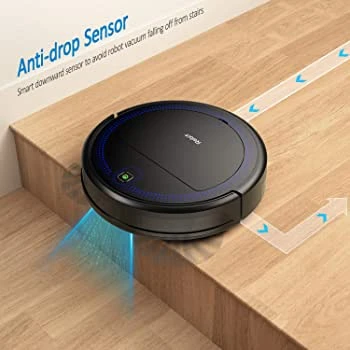
As innovative as they may be, anti-collision sensors are not completely foolproof. The effectiveness of these sensors rests on a number of critical factors, all of which must be taken into consideration to ensure optimal performance. These factors that impact the performance of anti-collision sensors range from lighting conditions and furniture placement to sensor positioning, and all play a critical role in how well your robotic vacuum cleaner will navigate your living space. In this section of the article, we will explore each of these factors in greater detail, highlighting how they can impact the performance of anti-collision sensors in different types of flooring.
Lighting Conditions
The lighting conditions in a room can greatly affect the performance of anti-collision sensors. Here are some points to keep in mind:
- Low Lighting: When the room is poorly lit, the sensors may not be able to detect obstacles accurately. This is because the sensors rely on detecting changes in light to detect objects in their path. If the light is too low, the sensors may not detect obstacles or may mistake shadows for obstacles.
- Harsh Lighting: On the other hand, harsh lighting can also be problematic for anti-collision sensors. If the light is too bright or too direct, it can interfere with the sensors’ ability to detect obstacles. This is because the light may reflect off of surfaces in the room, causing false readings or creating blind spots.
- Changing Lighting: If the lighting in the room changes frequently, it can also affect the sensors’ performance. For example, if the room has a lot of natural light that changes throughout the day, the sensors may struggle to adjust to the changing conditions. The same goes for rooms with dimmer switches or lights that are frequently turned on and off.
To optimize the performance of anti-collision sensors in different lighting conditions, it’s important to keep the lighting in the room consistent and adequate. Avoid using harsh lighting or lighting that changes frequently. Additionally, make sure that the sensors are placed in an area where they can easily detect changes in light without being affected by direct light sources or shadows.
Furniture and Obstacles
Anti-collision sensors in vacuum cleaners are designed to detect and avoid obstacles while cleaning. However, furniture and other obstacles can sometimes affect the performance of these sensors. Vacuum cleaners with anti-collision sensors use different methods to detect furniture and obstacles, and these methods can be affected by a variety of factors.
The following table highlights some of the common furniture and obstacles found in households and how they might affect the performance of anti-collision sensors.
| Furniture/Obstacle | Effect on Anti-Collision Sensors |
|---|---|
| Couch | The anti-collision sensor may detect the underside of the couch or the legs, causing the vacuum cleaner to avoid these areas. |
| Coffee Table | The anti-collision sensor may detect the edges of the coffee table, causing the vacuum cleaner to avoid getting too close to it. |
| Bookshelf | The anti-collision sensor may detect the sides and edges of the bookshelf, causing the vacuum cleaner to avoid getting too close to it. |
| TV Stand | The anti-collision sensor may detect the sides and edges of the TV stand, causing the vacuum cleaner to avoid getting too close to it. |
| Chair | The anti-collision sensor may detect the legs of the chair, causing the vacuum cleaner to avoid these areas. |
| Walls | The anti-collision sensor may detect the edges of the walls, causing the vacuum cleaner to avoid getting too close to them. |
| Corners | The anti-collision sensor may detect the edges of corners, causing the vacuum cleaner to avoid getting too close to them. |
It’s important to note that the above table is not exhaustive and that there may be other furniture and obstacles that can affect the performance of anti-collision sensors. Nevertheless, it gives a good idea of how common household items might affect the ability of vacuum cleaners to detect and avoid obstacles while cleaning.
To optimize the performance of anti-collision sensors, it’s important to keep furniture and other obstacles out of the way. This can be done by decluttering the area being vacuumed and moving objects that might hinder the performance of the vacuum cleaner. By doing so, the vacuum cleaner will be able to navigate the room more efficiently, providing a more thorough clean.
Sensor Positioning
One of the crucial factors that can affect the performance of anti-collision sensors is the position of the sensors themselves. Without proper sensor positioning, the sensor may fail to detect obstacles or furniture, which may lead to collisions.
Different types of vacuum cleaners have different sensor arrangements, which can also affect their performance based on the type of flooring they are being used on. The proper positioning of the sensor is critical to ensure that the anti-collision system of the vacuum cleaner works effectively.
Here are some recommended sensor positioning tips for different types of floors:
| Floor Type | Sensor Positioning Recommendation |
|---|---|
| Carpet | Place the sensors closer to the front of the vacuum, as carpets tend to trap dirt and dust. This positioning enables the vacuum cleaner to detect dust and dirt, allowing it to pick up the dirt or debris before it moves too far ahead. |
| Hardwood | Position the sensors higher than usual. The reason for this is that sensors placed closer to the ground may pick up shadows, which might lead to collision with furniture or any other obstacles. Placing the sensors higher minimizes the chance of detecting those shadows as obstacles, giving it the ability to detect and avoid obstacles more accurately. |
| Tiles | Place the sensors on the left or right side of the vacuum cleaner since tiles often have patterns, a positioning that minimizes the chance of detecting those patterns as obstacles, which can result in the vacuum cleaner stopping abruptly. |
In general, it’s important to keep the sensors unobstructed and ensure that they are not covered by dust, dirt, or debris. Also, avoid covering the sensors with cleaning accessories. Doing so will interfere with the performance of the sensors, making them inadequate for detecting obstacles or furniture around the area.
To conclude, it’s essential to understand the importance of proper sensor positioning to ensure that the anti-collision system of the vacuum cleaner works effectively. By ensuring that the sensors are positioned optimally, you can rely on your vacuum cleaner to move around your room freely without any damage to your furniture or risk of injury to your vacuum cleaner.
How to Optimize the Performance of Anti-Collision Sensors
You’ve invested in a high-quality vacuum cleaner with anti-collision sensors to help keep your floors clean and damage-free. However, if you’re not using these sensors to their fullest potential, you may still be experiencing the occasional bump or crash. So, how can you optimize the performance of your anti-collision sensors? The answer lies in paying attention to a few key factors that can affect their efficacy. By making small adjustments to your cleaning routine and environment, you can ensure that your anti-collision sensors are working as effectively as possible. Let’s explore some of these strategies in detail.
Keep Floors Clear of Clutter
An important factor to optimize the performance of anti-collision sensors in a vacuum cleaner is to keep the floors clear of clutter. This is essential because clutter can interfere with the proper functioning of the sensors and cause the vacuum to collide with objects.
To ensure your floors remain clear, start by minimizing furniture and obstructions that can make it difficult for the vacuum to move around. You can also declutter by picking up loose items such as toys, shoes, or clothes, and organizing them in the appropriate storage. Additionally, it is important to keep cords, cables, and electrical wires out of the way as they can easily tangle with the vacuum or interfere with the sensors.
Here are some tips for keeping your floors clutter-free:
- Place baskets, bins or trays in your entryway to store shoes or other items that tend to accumulate there.
- Organize your closet with proper storage systems to easily store clothing and accessories properly.
- Designate a specific spot or drawer to hold small items such as tech gadgets, jewelry or stationary to prevent scattering them around.
- Use cord clips or cable ties to keep cords and cables tangle-free and out of the way of the vacuum cleaner.
It is important to note that a clutter-free floor not only ensures that the vacuum cleaner’s sensors function properly, but it also promotes a tidy and organized living environment. By implementing these tips, it becomes easier to keep your floors clear and your home free from unnecessary clutter.
Use Adequate Lighting
The lighting conditions can have a significant impact on the performance of anti-collision sensors. Dimly lit areas may cause the sensors to malfunction and result in the vacuum cleaner colliding with furniture or other obstacles. It is essential to use adequate lighting to optimize the performance of the anti-collision sensors.
Here are some tips to help you use adequate lighting for your anti-collision sensors:
| Tip | Description |
|---|---|
| 1. Install Proper Lighting | Make sure that the room where the vacuum will operate has sufficient lighting. Install proper lighting fixtures such as overhead lights, lamps, or even motion-sensor lights to ensure that the sensors can detect obstacles accurately. |
| 2. Avoid Glare | Excessive glare and reflections can interfere with the accuracy of the sensors. Be sure to angle your lights in such a way that there are no harsh reflections or hot spots. |
| 3. Keep Windows Clean | Dirty windows can block natural light and make it difficult for the sensors to detect obstacles in their path. Regularly clean your windows to ensure unimpeded natural light. |
| 4. Use Color Correcting Light Bulbs | Some light bulbs emit light in a color range that can interfere with the sensors. Choose light bulbs that have a color temperature that is neutral or cool to optimize the performance of the sensors. |
By following these tips, you can ensure that your anti-collision sensors work efficiently, without any interruptions, and you can enjoy a smooth, bump-free cleaning experience. Remember, sufficient lighting is not only essential for the function of the sensors but also for safety reasons.
Choose the Right Vacuum Cleaner
When it comes to optimizing the performance of anti-collision sensors, choosing the right vacuum cleaner is crucial. Here are some factors to consider when making your choice:
- Type of vacuum cleaner: Stick vacuums and robotic vacuums are typically lighter and more maneuverable, making them a better choice for anti-collision sensors. However, if you prefer an upright vacuum, look for one with a swivel head that can easily navigate around furniture.
- Sensor compatibility: Some vacuum cleaners are designed to work specifically with anti-collision sensors. Look for models that have sensors built-in, or that come with special attachments for sensor-equipped vacuums.
- Suction power: The more powerful the suction, the better the vacuum cleaner will be at picking up debris from your floors. However, too much suction can also cause problems for anti-collision sensors by creating a strong airflow that disrupts the sensor’s readings. Look for a vacuum cleaner with adjustable suction settings so you can find the right balance.
- Noise level: Some vacuum cleaners are much louder than others, and excessive noise can be disruptive to anti-collision sensors that rely on sound waves to detect obstacles. Look for models that advertise quiet operation.
- Filter type: Higher quality filters can help reduce the amount of dust and other allergens that are released into the air. This can be important if you or anyone in your household suffers from allergies or respiratory issues.
Remember that different types of flooring may require different vacuum cleaners. Hardwood floors may be more susceptible to scratches from certain types of vacuum cleaners, while thick carpets may require more powerful suction to get a deep clean. Do some research and read reviews to find the best vacuum cleaner for your specific needs, and always be on the lookout for new models that incorporate the latest technological features.
Conclusion
In conclusion, anti-collision sensors are an essential component of modern vacuum cleaners. They work by detecting obstacles in the cleaner’s path and adjusting their movement accordingly to prevent collisions. Different types of flooring can affect the performance of these sensors, with carpet providing more resistance than harder flooring surfaces.
Factors such as lighting conditions, furniture, and sensor positioning can also impact the sensors’ ability to function optimally. However, there are ways to optimize their performance, such as keeping floors clear of clutter, using adequate lighting, and choosing the right vacuum cleaner.
It’s important to note that while anti-collision sensors can be incredibly useful, they are not foolproof. It’s still essential to take care when using a vacuum cleaner and to be aware of your surroundings to prevent any accidents.
All in all, anti-collision sensors represent a significant advancement in vacuum cleaner technology, but they are just one of many features to consider when choosing a vacuum. By understanding how they work and how to optimize their performance, you can ensure that you get the most out of this important vacuum cleaner feature.
Frequently Asked Questions
1. What is the purpose of anti-collision sensors in a vacuum cleaner?
The purpose of anti-collision sensors is to prevent the vacuum cleaner from colliding with walls, furniture, or other obstacles in a room.
2. Do anti-collision sensors work on all types of flooring?
Yes, anti-collision sensors work on all types of flooring, including carpet, hardwood, and tiles. However, the performance may vary depending on the type of flooring.
3. How do anti-collision sensors detect obstacles?
Anti-collision sensors use infrared or laser beams to detect obstacles in their path. When an obstacle is detected, the vacuum cleaner adjusts its trajectory to avoid a collision.
4. What are some factors that can affect the performance of anti-collision sensors?
Lighting conditions, furniture and other obstacles in the room, and the positioning of the sensors can all affect the performance of anti-collision sensors.
5. Can anti-collision sensors be disabled?
Most vacuum cleaners with anti-collision sensors allow users to disable them if needed, but it’s not recommended as it may cause the vacuum cleaner to potentially damage furniture or walls.
6. Do all vacuum cleaners come with anti-collision sensors?
No, not all vacuum cleaners come with anti-collision sensors. It’s usually a feature found in higher-end models.
7. How can I optimize the performance of anti-collision sensors?
You can optimize the performance of anti-collision sensors by keeping floors clear of clutter, using adequate lighting in the room, and choosing the right vacuum cleaner for the type of flooring you have.
8. Will anti-collision sensors prevent my vacuum cleaner from getting stuck under furniture?
Anti-collision sensors can help prevent your vacuum cleaner from colliding with furniture, but they may not necessarily prevent it from getting stuck underneath it. Some vacuum cleaners have additional features such as anti-tangle brushes to prevent this from happening.
9. Can I use anti-collision sensors to clean my stairs?
Anti-collision sensors are designed for use on flat floors, so they may not be effective on stairs. It’s best to use a handheld vacuum cleaner for cleaning stairs.
10. Are anti-collision sensors reliable?
Yes, anti-collision sensors are generally reliable and can prevent the vacuum cleaner from causing damage to your furniture or walls. However, like any technology, they may not always work perfectly, so it’s important to take other precautions to prevent collisions and damage.

